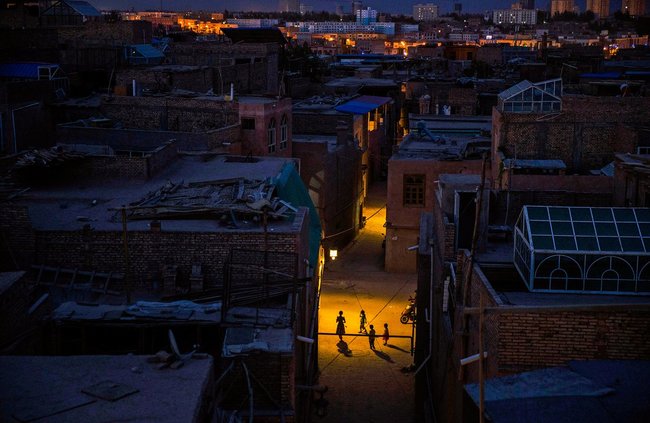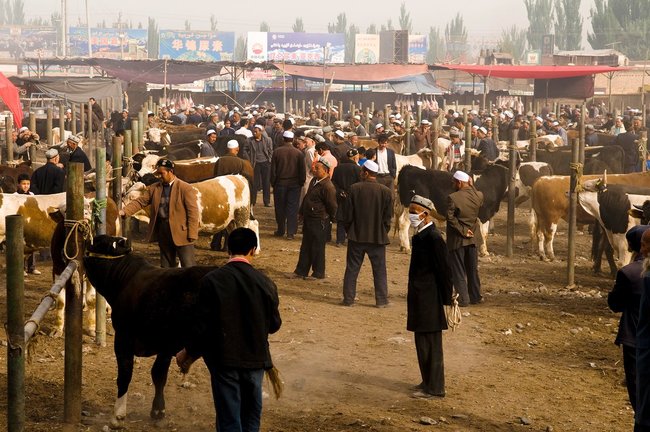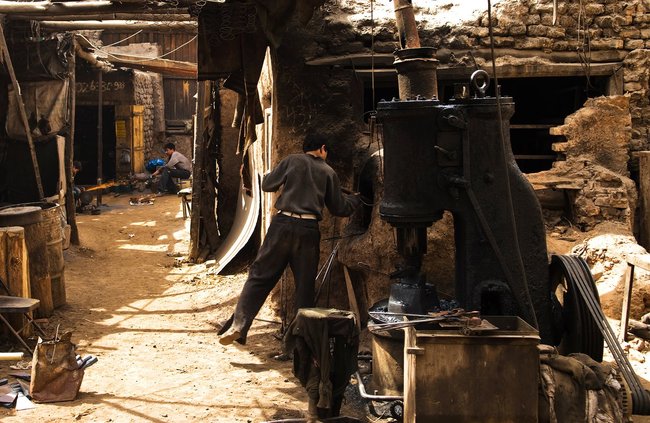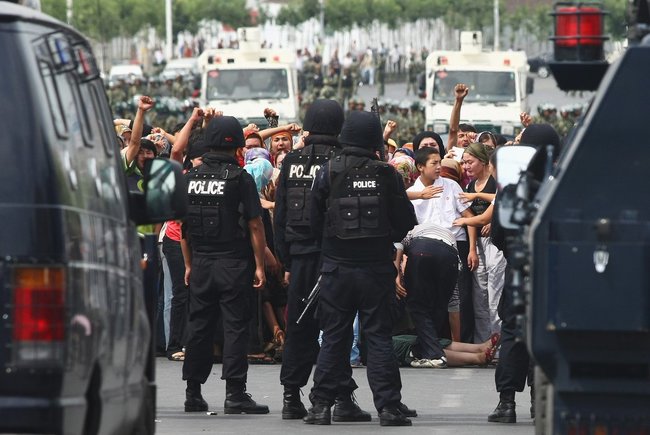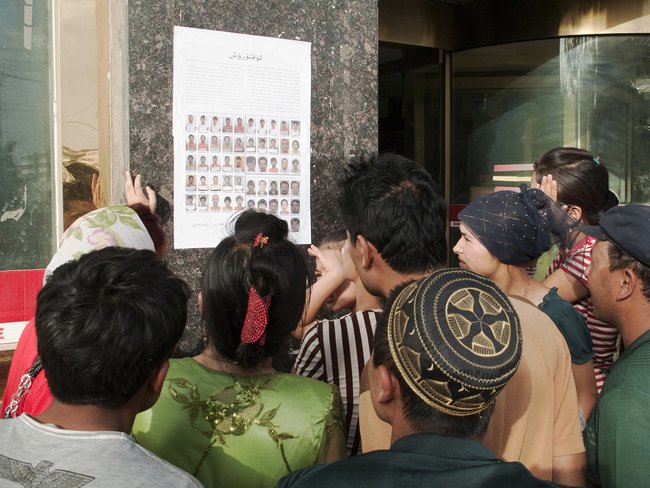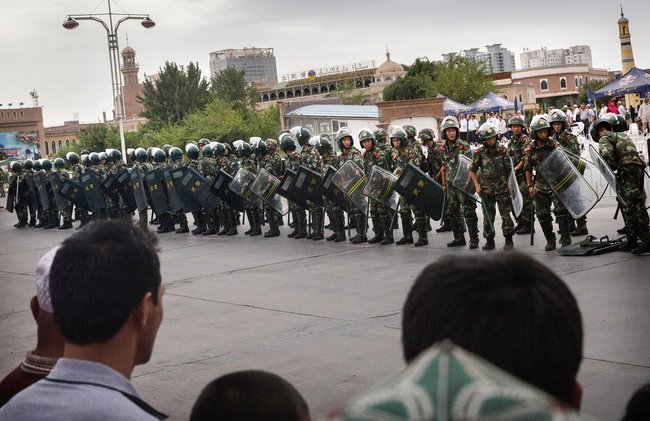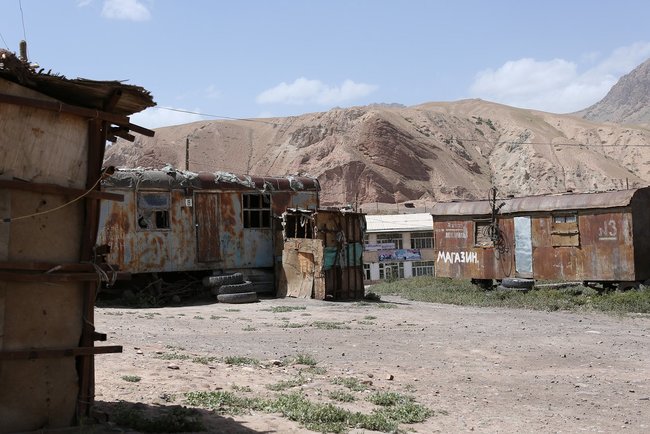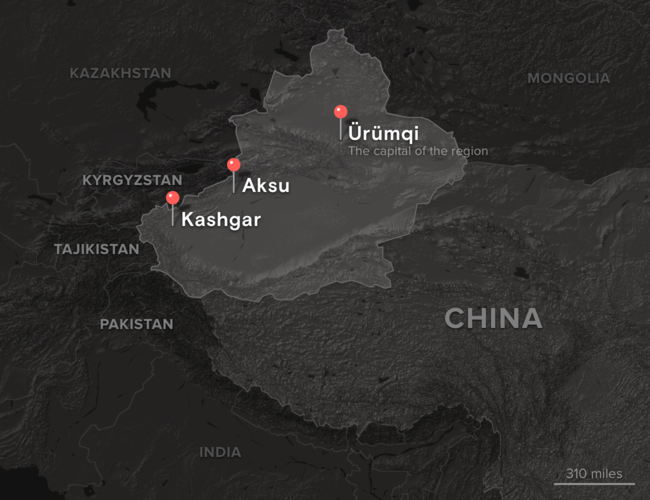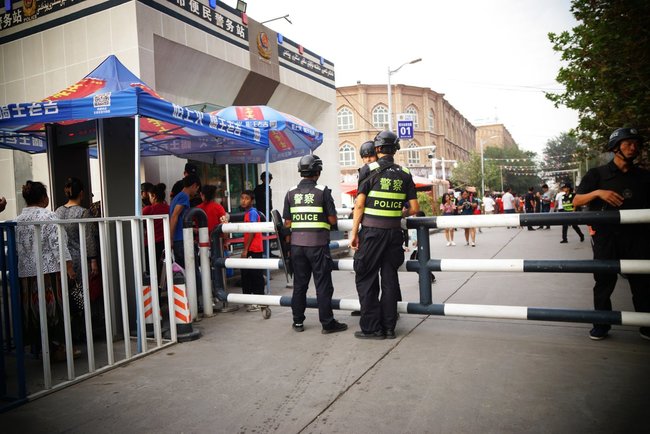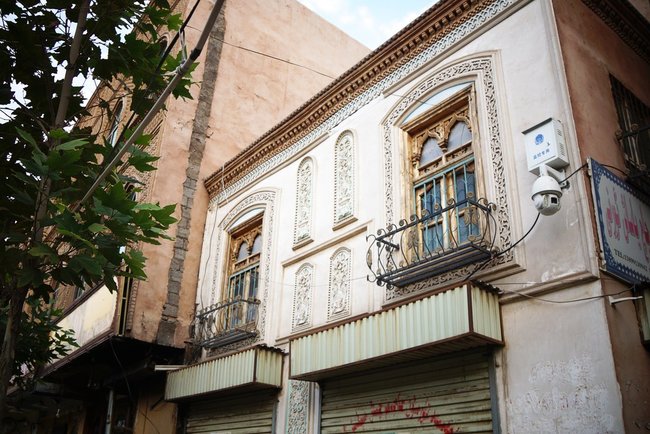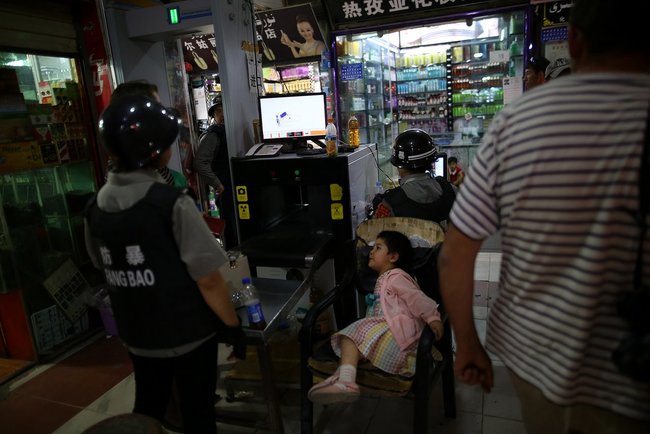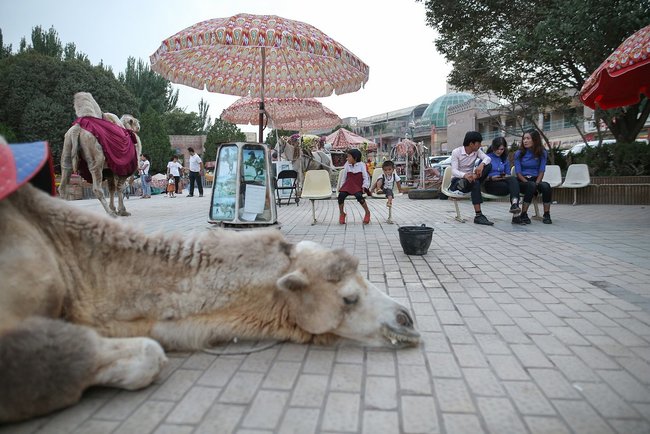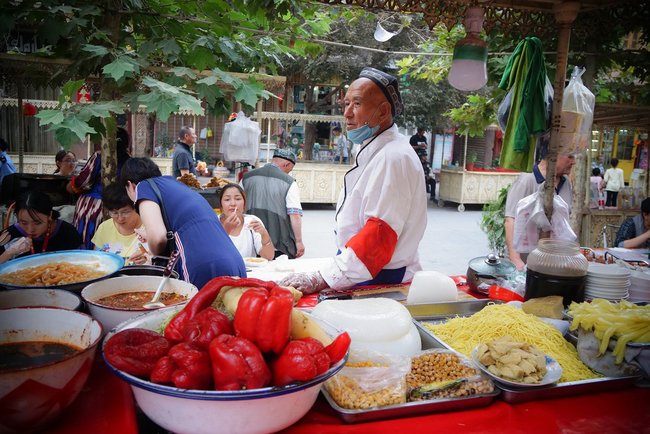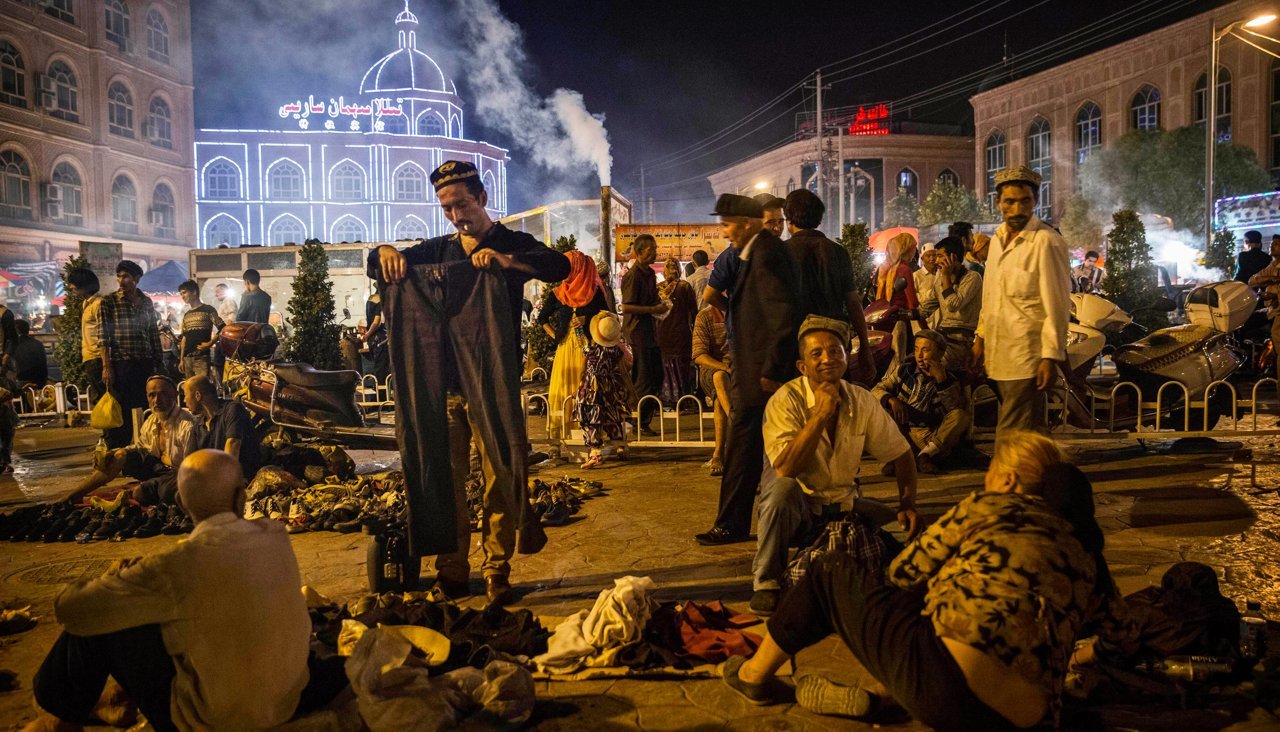
On September 9, Human Rights Watch published a report detailing the persecution of the Muslim population in China’s Xinjiang Uyghur Autonomous Region. The report describes widespread arrests of Uyghur people in the region by the Chinese authorities, who place those arrested in prisons and so-called reeducation camps. Millions of people in the region have fallen under the constant watch of a state-run video surveillance system, and their social status and even their overall path in life depend on points acquired in a “social credit” system. According to Human Rights Watch, repressions on this scale have been unheard of in China since the Cultural Revolution. According to The New York Times, U.S. President Donald Trump is considering introducing sanctions against China as a form of retaliation, but the situation in Xinjiang has generally gone almost entirely undiscussed, perhaps because tourists and journalists only rarely reach the area. Here, Meduza is publishing reporting by a Russian-speaking journalist and traveler who managed to enter Xinjiang during the summer and observe how the new technologies in use there facilitate total surveillance, segregation, and discrimination. The author of this piece has chosen to remain anonymous to protect his own safety and the safety of those he interviewed. Therefore, certain names and insignificant details in this story have been altered.
The Border
It was 15 years ago when I first arrived at Irkeshtam Pass, a border crossing that divides Kyrgyzstan from China. At the time, I was hitchhiking, and I was the only tourist in the entire checkpoint, a long halfpipe-shaped barrack with a ragged fence made of barbed wire. The barrack was divided in half by a boom gate and a desk occupied by a sleepy Kyrgyz soldier. The elevation there made it difficult to breathe. It was difficult to hold a conversation, too: wind howled over the border and dampened the sound of our words. It was a rather forbidding place next to a beat-up, two-lane road that led down to Xinjiang, a wide, mountainous region overgrown with thorns that also houses Taklamakan, one of the largest sand deserts in Asia. Directly across from the soldier’s desk, a new country began.
Lines of trucks stood on either side of the gate dividing the barrack. Some carried consumer goods from China to Central Asia and onward to Russia, and others carried machining stations left over from old Soviet factors from Tajikistan and Kyrgyzstan to China. Everyone knew which side was developing faster, but the signs of progress were barely noticeable even on the Chinese side, aside from the slightly less ragged barbed wire and the fact that the soldiers sat in a new booth made of glass and tile.
In 1935, Peter Fleming, a political correspondent for The Times (and a potential inspiration for the title character of his younger brother Ian’s James Bond novels) published a marvelous book about his travels in this area, News from Tartary: A Journey from Peking to Kashmir. It is difficult to imagine a more ironic title: the largest autonomous region in China, which occupies one sixth of the country’s square mileage, remained in Fleming’s words precisely Tartary, the name used until the 19th century for all the territory stretching approximately from the Caspian Sea to India, removed, inaccessible, and mysterious. Few Westerners managed to make their way here, and news traveling out reached the world over the course of months — if it made its way out at all.
In Chinese, “Xinjiang” means “new border” or “new dominion.” The region, first conquered by China in the 18th century, has been settled since ancient times by Uyghurs, a Turkic ethnic group whose language and clothing are significantly closer to those of Central Asian peoples than to those of China. As the Silk Road stretched its way around the desert, it used to join a string of cities here that served as oases separated from one another by a caravan journey of many days. These distances allowed the residents of this area, including Uyghurs, Kyrgyz, Kazakhs, Tibetans, and Russians, to live in relative peace, and the proximity of the great commercial corridor provided cultural ties to the West, India, China, and Persia. This area, which back then carried the general title of East Turkestan, was locked in conflict for centuries with Beijing, which regularly attempted to annex the territory although it was located 1.5 times as far away from Beijing as, say, from Baghdad. East Turkestan also experienced regular tensions with other neighboring territories.
From time to time, rebellions and civil wars raged here and turned the region into a bloodbath; sometimes, the interests of other great powers intersected here. That’s how Eastern Turkestan has landed in newspaper editorials, first during the Great Game, when the borders of China, Russia, and the British Empire pushed against each other at the Pamir Mountains, and then in the 1980s, when China supported Afghan mujahideen in their fight against the Soviet Union. Then, however, East Turkestan slipped into a period of obscurity following China’s final occupation of the region in 1949.
Kashgar, the Xinjiang city closest to the Kyrgyz border, seemed in 2013 to be a godforsaken hole in the ground. The tourists who visited the city on rare occasions settled down in two hotels that stood on the remains of two foreign consulates that closed in 1949, one Russian and one British. The surrounding city was composed of identical, brand-new Chinese housing complexes and pompous official buildings. A statue of Mao built in 1968, at the height of the previous wave of Uyghur unrest, rose above the central square. It used to be one of the largest statues of Mao in China. Behind its back, excavators were crushing an enormous set of earthworks into pieces.
It took me two days to realize that what they were destroying were not earthworks but an ancient city wall dividing outer Kashgar from the Old City kept safely inside. In the Old Town, people lived not only by their own traditions but by their own sense of time: when Chinese people working by Beijing hours went to sleep, those in the old Uyghur downtown were only just settling down to eat dinner. A crowd poured slowly out of the central mosque, trickling along the narrow alleys around the main square; people sat down unhurried at the tables that stood along the road or walked to the night market, which floated in a cloud of cooking smoke and the mouthwatering scent of fresh flatbread. The men were dressed in robes and wore long beards, knee-high boots, and tall fur-lined hats. Women dyed their eyebrows, and the men had knives hanging from their belts — these knives, the famous pchaki, were produced in the neighboring city of Yangisar, which had for centuries sold blades to caravans passing through on the Silk Road. At the enormous city market, people bought carpets, sheep, and dried lizards or snakes; on the streets, barbers shaved their clients out in the open and groomsmen shod horses with nails made on the spot in the workshop next door. Here, life seethed and boiled, life as Fleming had described it and as the great turn-of-the century explorers had described it before him. In the early aughts, arriving in Kashgar was like falling suddenly into One Thousand and One Nights, but a new life was marching in from all sides, and the Chinese quarter, which was previously located on the edges of the area, now created a ring that pressed in around the older buildings. Wandering here on moonless nights under the hundreds of crescents decorating the mosques, I understood that I was seeing all of this for the last time, and I was surprised at the patience with which the Uyghurs faced the upheaval ahead. At the same time, in neighboring Tibet, Chinese forces were drastically altering daily life under the authority of a forced police occupation. However, the resistance didn’t wait long. In 2009, the police attempted to break up a crowd that had gathered in Ürümqi, the capital of Xinjiang, to protest the killings of Uyghur laborers in southern China. These disturbances became pogroms; 197 people were killed, mostly Han Chinese. The authorities arrested thousands of protesters, and at least 30 of them were sentenced to execution by firing squad. In response, some Uyghurs turned to terrorist acts — primitive and badly organized but regularly sustained. In 2010, a man and a woman threw explosives into a crowd in Aksu; of the seven people killed, five were police officers. One year later, 15 young men armed with knives took control of a police office in Hotan to protest a prohibition on wearing paranjas, feminine garments equivalent to burkas. All the attackers were killed along with two employees of the police force. In July 2011, a series of explosions in Kashgar caused the deaths of 10 people. Thirty-three more were killed in a knife attack at a train station in Kunming in 2014. In the same year, a Chinese consulate in Kyrgyzstan was attacked, and a shrine in Bangkok that is popular among Chinese tourists was bombed. By then, the repressions within Xinjiang reached such a level that Uyghur people began to join international terrorist groups. In a rare interview with The Associated Press, Uyghur fighters who had settled in Turkey after participating in the Syrian war said they were interested not in jihad but in gaining experience in battle that they could apply during further conflicts in their homeland. In secret from their fellow Islamic State fighters, they studied the writings of Zionists in hopes of applying the Jewish experience to their own attempts at self-governance. In any case, the “Islamic Movement of East Turkestan,” which recruited no fewer than a thousand fighters to send to Syria, is now considered by a majority of Western countries to be a terrorist organization. That status soon became quite useful for China, which publicly joined the international War on Terror in 2014. All these years, information has emerged from Kashgar quite sparingly — after the violence in Ürümqi, the Internet was shut off for full a year throughout Xinjiang; Chinese authorities kept news about the terrorist attack in Aksu from spreading even inside of China. As before, tourists barely ever visited Xinjiang but for a few adventurers hoping to enter Tibet, which is closed to foreigners, and athletes who biked through the desert or crossed Xinjiang’s dangerous rivers. In an attempt to gain some kind of idea of what was going on, I corresponded with many of these visitors. In 2003, one of the athletes told me about a Kyrgyz man he had met in Ghulja who swore that he had witnessed a mass shooting in Kashgar. He had described in detail how military trucks carried the bodies away, “blood dripping out of them onto the road.” He even took the athlete to the place where it all happened. Several years later, a different group of tourists heard the same story from a resident of Kashgar. Later on, in one of the local villages, they met a group of Uyghur police officers, and one year after that, they heard upon their return to Kashgar that their acquaintances had all been stabbed to death by jihadists who were then shot by the authorities. In 2007, Xinjiang appeared on Russian television for the first and last time in this century: Four of the six participants in a boating trip led by Sergey Chernik drowned in the Yurunkash River. The case received widespread publicity, the police obviously investigated it, and the guide who started Chernik’s group on its route, like other Uyghur guides, continued to answer messages until 2015. After that, however, all lines of communication were broken. At approximately the same time, the World Uyghur Congress, a Munich-based human rights advocacy organization, began to publish frightening reports of people disappearing in Xinjiang. They explained that Uyghurs had been forbidden from contacting people from outside the borders of the province even if those people were their own relatives. One person after another stopped answering the phone; Chinese Uyghurs deleted friends living abroad from their contact lists on WeChat, the most popular Chinese messaging platform. WhatsApp and Facebook had already been blocked years earlier, but now, those who used them faced the threat of prison time. Back then, these rules applied only to voice calls and written chats, and some parents spoke with children studying beyond the border through video chats, their spoken words diverging sharply from the messages they displayed simultaneously on pieces of paper held up to the camera. One Xinjiang resident managed to keep up connections through video calls embedded in video games. Then, the silence became complete. One of my friends, a German bicyclist who traveled to Xinjiang in the fall of 2016, said that the city of Hotan seemed to him to be “entirely enmeshed in barbed wire.” Official rhetoric had also changed: In Beijing, officials no longer claimed that the opposition was composed of a small number of extremists. “It’s impossible to tear out weeds one by one,” said one party official in Kashgar. “We need chemicals that can deal with all of them at once.” A few years before then, Chinese video cameras appeared in Tibet that were capable of sending the state messages about the movements of specified people targeted for surveillance. They looked like rotating orbs the size of a human head, and they were equipped with two “eyes.” My Tibetan friends believed the anthropomorphic design was intentional, a deliberate scare tactic. But in Xinjiang, when Chen Quanguo, known as “the repressor of Tibet,” became the secretary of the local Communist Party, police tactics took on a magnitude that was frightening even by Tibetan standards. In one of his first planned speeches, the new party chief promised to “bury the bodies of terrorists in the boundless sea of a people’s war.” Within three months, the arrests had begun, and by April 2017, one could be repressed for displaying excessive religiosity, wearing a paranja, having a beard, wearing excessively traditional clothing more generally, publicly interpreting the Koran, and even giving one’s children Arabic names. Orders for required quotas of arrests trickled down to local policemen, and in some population centers, those figures reached 40 percent of the population. Those who resisted were sent to “reeducation camps,” places whose armored gates and thick walls topped with barbed wire seemed to sprout out of the desert and which were always heavily guarded. When Uyghur sources began speaking about the hundreds of thousands of people held in these camps, I finally decided to return to Xinjiang. This time, I traveled in my own car, but getting into China turned out to be far more difficult than it had been 15 years before. I received permission to enter over the course of six months — only a licensed Chinese tourist agency had the ability to sign my entry papers. A guide was supposed to meet us at the border, and I had been sent his phone number in advance. Calling an Uyghur guide from a foreign number would have been impossible, but the strictness of Chinese laws was, as usual, partially compensated by a willingness to break them: the agency advised me simply to borrow a telephone from the border guards. The majority of Chinese oil and natural gas is extracted in Xinjiang, and fuel from Russia is transported into China through the province, but most importantly, the region has been designated as a central hub in the “One Belt, One Road” project, a global Chinese infrastructure initiative intended to connect markets in China, the Near East, and Europe. As a result of all this, the underdeveloped region began to see a grandiose influx of resources. As it brought its road network up to European standards, China began to subsidize construction projects among its neighbors — a new railroad will connect Xinjiang to Kyrgyzstan and Uzbekistan. The trains have not begun running yet, but the highway that I took in my earlier trips is now covered in respectable asphalt. There were no longer barracks along the border pass. In place of a sleepy soldier, an entire division in contemporary military uniforms stood on the new Kyrgyz outpost. In 2014, not far from the border, there was a traffic accident in which 11 Uyghurs crossing the border and one Kyrgyz park ranger were killed. Those killed did not have firearms with them, but a Koran, a compass, a knife, a rope, and a shroud were found among the possessions of each one. The Kyrgyz government and a Chinese commission considered this collection of items to be a sign of terrorist activity; it was decided that security along the border would be strengthened. On the Chinese side, the only new thing was the barrier before which the stony-looking soldier on guard photographed our faces and punched our passport numbers into a computer. Fifty meters away, near the next barrier, five soldiers carefully searched my car. They checked our passports again and once again took pictures of the passengers. In the course of the next 20 minutes, we passed through three more checkpoints — and drove past no fewer than 10 video cameras. By the next barrier, a guard in white gloves used his baton to direct us to an enormous, modern-looking building with gates that opened and closed automatically. It was full of scanners and X-ray machines that reminded me of shiny new medical equipment. Our guide, a thick-set Uyghur in a tracksuit, was waiting for us there. With a guilty smile, he confessed that these checkpoints had been a mere warm-up — we would soon have to pass through three phases of customs enforcement, each of which would include between two and four steps. For starters, the border guards looked through the contents of all our telephones, deleting photographs taken in the neutral zone behind us. Our luggage passed through an X-ray machine. Books and notes were examined separately, and Freedom at Midnight, a thick tome about the partition of India and Pakistan, caused particular consternation. The guards had to contact their commanders by walkie-talkie and ultimately determined that the word “freedom” could not be grounds for confiscation. Then, they drove our car into a box for X-ray screening, but because the resulting snapshots could not be examined there and instead had to be sent to an analytical division in Ürümqi, 930 miles away from us, we waited for an hour before receiving a response. The images had been too low-quality — the car had to be scanned three times in total. Each time, thanks to the strength of the X-ray beams in the box, a radiation detector was triggered and a siren let out an extended howl, but no one paid it any attention. After the customs inspection, a military one began — people in uniform plugged a special device into all our computers that would scan our videos, photos, contact lists, and text files. They searched for maps, faces, and names. The gadget, embossed “Mobile Hunter” in English on its resin case, could not connect to my old notebook, and my photographs were examined manually. I was worried because my computer contained portraits of my old Uyghur friends, but the soldiers worked clumsily and found neither them nor my archive of Tibetan photographs. For a moment, though, I was frightened: in all my years traveling in China, I had never had to deal with anything like this. Soldiers had taken telephones from the tourists who were undergoing examination near us and had begun to install a special app called JingWang Weishi that is used in Xinjiang for surveillance of the Muslim population. JingWang sends the police an identification number for the device, its model, and the telephone number of its owner before monitoring all the information that passes through the telephone, warning the user when it finds content that the government deems dangerous. I had read about this application before but thought its existence to be a false rumor. After five hours at the border, though, I had already learned that installing the app had become mandatory for all Xinjiang Uyghurs. I managed to hide my cell phone when the right moment came. After the military inspection, we were told to continue to a passport control station located 85 miles inside the country. The road was unrecognizable: a magnificent new highway looped its way through the sandy hills, periodically diving into tunnels and crossing rivers on bridges of a sort never before seen in Asia. Strangely, there was barely any traffic on it, but at one point, our car was suddenly surrounded by camels, the descendants of those furry, two-humped Bactrians on whose shoulders the Silk Road had rested. They were enormous and rose above the car like robots from Star Wars. They galloped a bit on the highway and, leaping easily over the tall metal barriers enclosing it, made their way back into the desert at a run. In the desert they roamed, it seemed that Xinjiang had not changed at all: it remained boundless with a sea of sand dunes, migrating lakes, snowy peaks on the horizon, and roaring rivers concealed in its narrow but bottomless canyons. As before, every trip on the highway promised adventure, and I had the urge to drive down away from the road and swoop in circles among the sandy hills, preferably without needing another stamp on my passport beforehand. On this trip, such a thing was impossible. Every few miles, a camera preserved every movement that crossed into view. Each of them only had one eye, but they were often clustered in groups of three to five. The cameras register not only a car’s license plate number but also the face of its driver. At night, lights are projected over the camera lenses, blinding drivers more than oncoming headlights ever could. As we drove past another checkpoint, I tried to shield my eyes with my hand in an attempt to catch a glimpse of the road. The gesture did not go unnoticed: all four cameras immediately flashed a series of strobe lights. Every 15 or so miles, the road was blocked by heavy-duty steel barriers and spike strips capable of stopping a tank. Long lines of passengers from Uyghur buses stretched out from tourniquets that led to booths with facial scanners and then to small windows where the results of the scan were compared with a plastic ID card. Many passengers were asked to pull up the Mobile Hunter application on their cell phones or to enter their passwords and simply hand the phones over to police. People lined up casually, as though by force of habit, and at every checkpoint, a cluster of those same hanging cameras watched them from the ceiling. I noticed that only very elderly men have beards nowadays. Three years ago, the Chinese government announced that private and state-owned CCTV surveillance systems that use facial recognition would be unified into a shared database that would encompass the entire population by 2020. Xinjiang, which had also been the site of the first Chinese nuclear weapons tests, was once again chosen as the site of a pilot experiment. This is where the majority of the 20 million CCTV cameras at work in the country are located. Their astonishing numbers, palpable even to the naked eye, have been confirmed by official sources. By 2016, Chinese government spending on internal security had exceeded spending on external defense by 13 percent. Between 2014 and 2016, Xinjiang spent twice as much on surveillance as the rest of China’s regions; in 2017, it spent three times as much. Now, Chinese police can find and arrest any suspect in a crowd whose facial features correspond with existing data in the country’s grandiose central database in the course of seven minutes or less. After successfully introducing this surveillance system in Xinjiang, Chinese authorities moved to export its breakthrough technology. Two years ago, CEIEC, a Chinese government-owned surveillance infrastructure company, opened its doors in Ecuador. China, the largest importer of Ecuadorian oil, lent the country millions of dollars in credit for the project, which would oversee the installation of security cameras in almost two dozen Ecuadorian provinces. In January 2018, Xinhua News reported that crime in Ecuador had fallen by 11.8 percent thanks to the new system. As part of the agreement, CEIEC will also introduce a geolocation system capable of tracking citizens’ mobile phones. Branches of CEIEC have appeared in Cuba, Brazil, Bolivia, and Peru, and the company has created an Internet censorship system for the government of Uganda in its continuing attempts to expand in Africa. On CEIEC’s website, only one agency appears under the page titled “Europe.” It is located in Moscow. Within Xinjiang itself, the new regime of video surveillance has no limits. In the very first year that Chen Quanguo was in power, 10,000 new officers were added to the police force, and the number of law enforcement officers continues to rise (Uyghurs themselves are often chosen for the lowest ranks). At one point, I observed a police training session at a post near the entrance to Kashgar. Some 20 men and women marched back and forth and ran from one point to another, clearly trying to surround an invisible crowd of people. The new recruits did not yet look too terrifying, but the same could not be said of their weapons. Only the Chinese commanders had machine guns; the Uyghurs were armed with spears that had resin shafts and steel blades, long truncheons that were so large that they could only be held with two hands, and objects resembling old yokes that could be snapped around the neck of an opponent. I had seen similar yokes in Tibet, where they were likely meant to stop people from setting themselves on fire. With the yoke clasped around the neck of a lama, a police officer could immobilize him while remaining at a safe distance. In Xinjiang, a different model was in fashion: the previously wooden parts of this construction had been replaced with pieces made of plastic and resin, and the glint of electric shock points was visible on the ring itself. Similar shocking devices were installed on the shields that police officers took with them whenever they patrolled in public. The bottom of each shield was split by a frightening-looking serrated opening that was clearly also intended for the neck of its victim. I managed to get my car cleared and receive a stamp confirming my entrance to the region only the following morning. I had spent about 26 hours in the general tangle of crossing the border. In the second half of the following day, I finally arrived in Kashgar, or, more precisely, in the new city that had taken up residence where the fantastical capital had previously been located and to which I had longed to return for so many years. The general architecture of Chinese cities has gone unchanged since the seventh century B.C.: you will always find a network of symmetrical rectangular neighborhoods stretching from north to south. It is impossible to turn the broiling chaos of narrow Uyghur alleys into anything consistent with that model. Chinese urbanists warred with the structure of Old Kashgar for decades, but I couldn’t even guess at what they wanted to turn it into. The dark alleys, shabby walls, and sand-brick mosques no longer exist. But in their places stand not Chinese skyscrapers but a kind of Disneyland, shocking in the scope of its conception. The Chinese turned this ancient oasis into a new, cozy-looking city, trying with all their might to create the appearance of an old way of life. The narrow alleys have become wide avenues that can easily be traversed by a fire truck — or an armored car. Every house is connected to running water and a central sewage system. But the spirit of the place has disappeared, just like the smoky smell disappeared from the small kitchens of the city after all its houses were connected to gas lines. As for the houses themselves, only the carved doors remain to give them a touch of authenticity. The new structures are reminiscent of old Uyghur architecture, but the painted walls look somehow illusory. The machine tool-cut window trims cannot be compared to their vanished predecessors just as new tiles can never really replace old pavement. By far the greatest loss has been the disappearance of Kashgar’s old street life. The blacksmiths and the hawkers are all gone, as are the carpenters who would carve vases out of gourds beside the road, the street vendors, and the donkey-pulled carts that played the role of taxis in the city. Old men in skullcaps sit along the flower-lined avenues and decorously drink their tea out of piyālas just as they always have, but they have a lost look about them, and the Chinese tourists taking photographs of them far outnumber the men themselves. At the food market, which has remained in its former location, people still barter for noodles and lamb heads, but the buyers are now all Chinese, and the sleeves of the Uyghur sellers are now graced with yellow text on a red patch testifying to the fact that the wearer has received a government license. I tried to find my old acquaintances, but I couldn’t even find the houses where they had lived back then. Instead, when I looked in absolutely any direction, I could see a police outpost surrounded by barbed wire. CCTV cameras are everywhere: on the roofs of houses, on brackets attached to the walls of buildings, on street lamps, and on metal racks installed specially over the streets for the express purpose of housing cameras. The city is split into square regions, and in order to cross from one quarter into another, every Uyghur must display a plastic ID, hand over any bags or purses to be searched, undergo a pupil scan, and, in some cases, surrender a mobile phone for inspection. The same procedure awaits them at the bank, in the hospital, at the supermarket, and at underground crosswalks. Armored cars patrol the streets along with divisions composed of Uyghur volunteers; they stop pedestrians periodically to verify their identities. After noticing that I had photographed a police officer, three such volunteers forced me to delete the picture and followed us for the rest of the evening without making any attempt to hide their efforts. I was able to find a couple of surviving mosques, but locks held their ancient doors closed. Not far from the madrasah, which was also closed, a furrier sat at an intersection in traditional dress and crafted an Uyghur hat. Both the furrier and the hat were made of bronze. Real fur hats were sold in the city’s souvenir shops, but real furriers were now impossible to find. The marvelous ancient knives that had graced the city on people’s belts and in market stalls had also disappeared. When I greeted a few salesmen and used the word “pchak,” they recoiled, and only one antiques dealer could find a heavy knife case in his stand. Inside were several sumptuous, ancient knife handles — the blades themselves had been cut off. Even when they buy everyday kitchen knives, Uyghurs are now obligated to brand the blade with a laser-carved QR code that identifies the knife’s owner. In Aksu, knives in restaurant kitchens are attached to the walls with chains.Silence
News from Tartary
Disneyland

